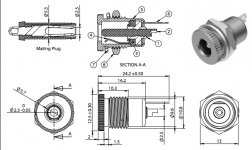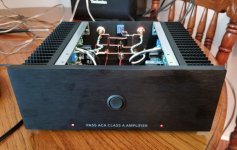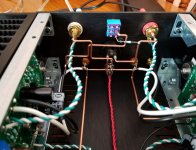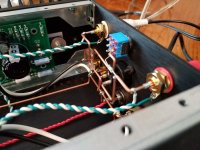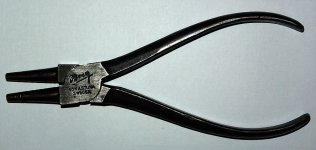Does anyone know what size male dc barrel end is needed for a proper connection to the female barrel plug that is included with the ACA kit? I tried searching for it but no luck.
http://www.tensility.com/pdffiles/54-00064.pdf
https://www.meanwell.com/Upload/PDF/GST120A/GST120A-SPEC.PDF
Attachments
Hi all, found this mounting guide for power resistors. Good luck with your Build.
http://www.rcdcomponents.com/rcd/pr...ines for RCD Leaded Resistors & Inductors.pdf
Moto
Thanks for locating that reference. Even if I apply a "near enough is good enough" approach in practice, I still like to know what the "best practice" is so I can make a judgement call.
Cheers
...And another one powers up!
Just completed my ACA build a few minutes ago. With the exception of an Elecraft K2 Ham transciever, this is my first venture into the solid state world after two decades of building tube circuits. I used a combination of the ACA 1.5 guide and the pics 6L6 posted earlier in this thread (#5075, if memory serves), guessing that the rear panel wiring is switchable between stereo and bridged mono; so far so good... nothing's burning yet. I had some exotic, oxygen-free copper 14 gauge bus wire (read: straightened THHN house wire ) left over from a previous tube amp project, so I put it to use here for a 1920's "breadboard" effect.
) left over from a previous tube amp project, so I put it to use here for a 1920's "breadboard" effect.
To say I'm quite pleased is an understatement. My test setup does have some, er, shortcomings; I'm using my laptop as a source (may not be capable of 2 V output), and my speakers are a pair of Technics SB-LX10 bookshelf jobs rated - and I suspect generously - at 89 dB. I'm getting some lovely sounds out of this despite all that, however. I can't quite put my finger on it, but the sound is very smooth and detailed without being "sterile". Highs are very crisp, and there's plenty of relatively well-controlled bass (well, as far as I can tell anyway given the limits of these speakers). Can't wait to plug this into my main setup for sure.
Thanks again to all on the forum who worked so hard to make this possible!
Just completed my ACA build a few minutes ago. With the exception of an Elecraft K2 Ham transciever, this is my first venture into the solid state world after two decades of building tube circuits. I used a combination of the ACA 1.5 guide and the pics 6L6 posted earlier in this thread (#5075, if memory serves), guessing that the rear panel wiring is switchable between stereo and bridged mono; so far so good... nothing's burning yet. I had some exotic, oxygen-free copper 14 gauge bus wire (read: straightened THHN house wire
To say I'm quite pleased is an understatement. My test setup does have some, er, shortcomings; I'm using my laptop as a source (may not be capable of 2 V output), and my speakers are a pair of Technics SB-LX10 bookshelf jobs rated - and I suspect generously - at 89 dB. I'm getting some lovely sounds out of this despite all that, however. I can't quite put my finger on it, but the sound is very smooth and detailed without being "sterile". Highs are very crisp, and there's plenty of relatively well-controlled bass (well, as far as I can tell anyway given the limits of these speakers). Can't wait to plug this into my main setup for sure.
Thanks again to all on the forum who worked so hard to make this possible!
Attachments
Just completed my ACA build a few minutes ago. With the exception of an Elecraft K2 Ham transciever, this is my first venture into the solid state world after two decades of building tube circuits. I used a combination of the ACA 1.5 guide and the pics 6L6 posted earlier in this thread (#5075, if memory serves), guessing that the rear panel wiring is switchable between stereo and bridged mono; so far so good... nothing's burning yet. I had some exotic, oxygen-free copper 14 gauge bus wire (read: straightened THHN house wire) left over from a previous tube amp project, so I put it to use here for a 1920's "breadboard" effect.
To say I'm quite pleased is an understatement. My test setup does have some, er, shortcomings; I'm using my laptop as a source (may not be capable of 2 V output), and my speakers are a pair of Technics SB-LX10 bookshelf jobs rated - and I suspect generously - at 89 dB. I'm getting some lovely sounds out of this despite all that, however. I can't quite put my finger on it, but the sound is very smooth and detailed without being "sterile". Highs are very crisp, and there's plenty of relatively well-controlled bass (well, as far as I can tell anyway given the limits of these speakers). Can't wait to plug this into my main setup for sure.
Thanks again to all on the forum who worked so hard to make this possible!
Nice build!
Did you use a tool like the attached image to bend the copper wires so it gets a round bend?
Attachments
Thanks, Mrshazbot. That bus wiring is a PITA, but it makes for a cool effect - and it's rigid. My experience building tube circuits makes me a bit hesitant to leave wires flopping about, although I doubt it makes much difference here with the low voltages involved. Old habits die hard I suppose. One additional benefit of this scheme is that it can provide the builder with additional points for attaching other wires or components, hence the rather odd positioning of the output wires seen in the pictures above.
I wouldn't be so quick to diss your build, though. I'll bet it looks at least as good as any other shown here, and it most certainly sounds as good I'm sure. Besides, you built the thing. Most others are happy to buy some POS from a big box chain. You should be proud!
I wouldn't be so quick to diss your build, though. I'll bet it looks at least as good as any other shown here, and it most certainly sounds as good I'm sure. Besides, you built the thing. Most others are happy to buy some POS from a big box chain. You should be proud!
Last edited:
Hi MEPER. Oddly enough, I used a pair of smooth-jawed (i.e. non-serrated) needlenose pliers for bending the bus wire. It (it being the wire) is sufficiently stiff so that it naturally takes a round bend just past the sharp edge of the jaws without leaving much of a nick. The trick is that you have to plan ahead for each bend.
I did use a pair of conical-jawed looping pliers (normally used for jewelry) for bending the leads of those parts on the PC board. They make smooth, even curves possible without stressing the parts themselves.
I did use a pair of conical-jawed looping pliers (normally used for jewelry) for bending the leads of those parts on the PC board. They make smooth, even curves possible without stressing the parts themselves.
Last edited:
1. Check the power supply connection at ACA back panel, make sure it is a good connection that can sustain constant current draw of around 3-3.5A (!)
2. Try a different power supply
- 2a) what you described is a typical SMPS short-circuit protection behaviour (due to a short between heatsinks and MOSFETS?), or some other wiring problem(s)...?
- 2b) the SMPS might be faulty - if the switching circuitry cannot achieve the rated switching frequency (at high voltage side...)
There is "bulb testers" info on Pass forums; try that as well
...If you have an auto-transformer, tone generator and oscilloscope, you'll be able to pinpoint the root cause fairly quickly.
Good luck, let us know what the problem was once you fix it.
Removed power supply lead to the two boards until I found the problem one. Once I unscrewed the PCB from the chassis, no more short problem. But once I bolted the power Mosfets back on, short. I replaced both Keratherm insulators since one looked as if it had a pinhole? I must have damaged it during installation?
Anyways - listening to the amp right now - gain is definitely lower than my Adcom 545, but nothing a twist of the volume can't fix. 6-7-8? Watts sounds pretty good, even on a pair of 86dB Wharfedale Denton mini-monitors.
Glad you found the problem; things like that can be vexing, particularly if you think they're self-inflicted. Last month I completed a pair of tube SE monoblocks. When I powered them on for the first time (note that I'm loath to use the phrase "fired 'em up" in this context), the left channel was almost dead silent. When I turned up the source I could hear the fainest hint of distorted audio.
I inspected my wiring a few moments later and discovered that I'd soldered the coupling cap from the plate of the first stage to the cathode of the output stage. D'oh! Now I see these gremlins can just as easily appear in the solid state world, too.
Before starting my ACA build I was afraid of doing something similar, but with more immediate (and disastrous) results. Turns out I needn't have worried. This is a great first time build, and as such is a simple circuit to troubleshoot if things go awry. That it sounds so good is icing on the cake.
I inspected my wiring a few moments later and discovered that I'd soldered the coupling cap from the plate of the first stage to the cathode of the output stage. D'oh! Now I see these gremlins can just as easily appear in the solid state world, too.
Before starting my ACA build I was afraid of doing something similar, but with more immediate (and disastrous) results. Turns out I needn't have worried. This is a great first time build, and as such is a simple circuit to troubleshoot if things go awry. That it sounds so good is icing on the cake.
Nag I was using a pair of 3 inch surroundsound speakers that were 30+ years old that I got from the big box store efficiency 84 or 85 and I just finished building my power supply not correctly so I only had 15 V power and I could easily turn the volume up to on comfortable level. Then I built a horn loaded speaker cabinet using the CNC machine at my college and downloading the files to cut the wood for the BK-20 cabinets and use the (Foster FE206En) driver 96 efficiency. No lack of detail, vary bright highs, using a signal generator my oscilloscope and slowly turning up the frequency I found at 64.7 Hz was the residence frequency I guess of the sheet rock wall board in my kitchen cabinets shook the silverware made the glasses bounce Picture frames on the wall rattled and the neighbors asked what the hell was going on. My source was my Microsoft surface pro 4 laptop my preamp IFI BlackLable or DarkVoice 336SE when listening to music 9 o’clock position was as high comfortable level, 11 o’clock was too loud and I didn’t want to damage my speakers after that.Hi Guys,
One small question.
ACA output power is approximately 5Watt.
Seas Prestige FU10RB-H1600-04 4" Full Range sensitivity is 85dB.
at 4 meters distance is ACA capable of producing medium ( I mean I can talk to my friend while listening to music) sound. or is ACA too low ?.
Thanks,
Nag.
I did change my capacitors to the (Nichicon MUSE 35V) because I had extras from previous projects I buy in bulk to reduce prices I know I’ll always use them later on.
I discovered going to ( Planet10 ) website if you want to know more about full range speakers he has a treasure trove of information in source on products. There’s more to Planet10 than meets the eye pardon the pun,lol
Hi Nag,
If this calculator is anywhere close to correct, then your experience sounds about right. I get a whopping 1 dB SPL increase with the following input:
YMMV...
If this calculator is anywhere close to correct, then your experience sounds about right. I get a whopping 1 dB SPL increase with the following input:
- 85 dB speaker sensitivity
- 5 WPC amplifier power
- 13 feet from speakers (~ 4m)
- 2 speakers total
- ...and speaker placement near to a wall
YMMV...
Last edited:
Removed power supply lead to the two boards until I found the problem one. Once I unscrewed the PCB from the chassis, no more short problem. But once I bolted the power Mosfets back on, short. I replaced both Keratherm insulators since one looked as if it had a pinhole? I must have damaged it during installation?
Anyways - listening to the amp right now - gain is definitely lower than my Adcom 545, but nothing a twist of the volume can't fix. 6-7-8? Watts sounds pretty good, even on a pair of 86dB Wharfedale Denton mini-monitors.
Good that you got it working. You could also sand-off the heatsink surface with fine sandpaper, before installing the MOSFETs, and always check for shorts...
I also have 4 ohms / 86dB Dynaudios. They sound great (in general!); really nice even with 3W single-ended tube amps, due to their flat-ish impedance curve across the audio band.
The gain can be increased on ACA by replacing the feedback resistor with 68K or so... but distortions will go up, and damping factor will decrease.... It all really depends on your preferences; it may work with Dynaudio's....?
All of the testing I've done like this used only a resistive load. Is the cap added in series or parallel to the resistor? What are typical values of capacitance that should/should not cause trouble for the typical Pass clone?
Eric
In parallel.
Start with small values (.22uF) and check for stability and oscillations. You may miss the oscillations if your time base is set to "look-at" up to 20kHz only...
Connect the resistors and capacitors through a speaker cable you'd normally use with your speakers
No need to push the ACA to oscillations/destruction with the capacitive load, I mentioned it just as a precaution to ensure the amp is stable with let's say 0.22uF load... Some people use ribbon cables; these can introduce a fair amount of capacitive load.
What you want to ensure is that there are no oscillations at all during normal operation. The amp is missing the Zobel network, so... a bit of caution, testing and reassurance can't hurt.
Hi Nag,
If this calculator is anywhere close to correct, then your experience sounds about right. I get a whopping 1 dB SPL increase with the following input:
I'm getting similar results from the pair of speakers I mentioned in post #5132 above. Clearly this amp is best matched to a pair of high efficiency speakers, but what I've heard in the mere hours I've had it up and running has convinced me that it would take a cheap-a**ed pair of speakers indeed to make this amp sound truly bad. And remember: failing that you can always get a 24V power supply, jack up the bias to 12V, and prepare to party hearty - sort of.
- 85 dB speaker sensitivity
- 5 WPC amplifier power
- 13 feet from speakers (~ 4m)
- 2 speakers total
- ...and speaker placement near to a wall
YMMV...
Thank you Mr. Zenith.
Got my parts kit today. I wish I wasn’t moving in several weeks. Gonna have to wait until we get settled in. Maybe by then some of the new surprise preamp designs may be out!
What are you talking about...if you got the full kit, you can built it in few hours. All is there. Soldering in 30 min. Putting box together, 30 minutes. Break for beer 30 min. Mounting power transistors, wiring the internals, 30 min. Powering it up, waiting for warm up, adjusting 10 volts on Q2, 30 min. Break for music, 30 min...all in few hours. I would not be able to wait few weeks, makes no sense. Believe me, I got 3 aca's.
Maybe by then some of the new surprise preamp designs may be out!
BA3 front end is good preamp.
So with my pair of ML Motion 40's 92db at 4ohms, the bridged monoblocks are starting to open up. Seems it takes longer than a few hours to break them in. One minor concern the heat output measuring the heatsinks is steady at 135F in a 76F room once its up to temp. Normal?
Thanks again to all on the forum who worked so hard to make this possible!
Can’t agree more thank you all. And Mr Zenith nice build!
- Home
- Amplifiers
- Pass Labs
- Amp Camp Amp - ACA

